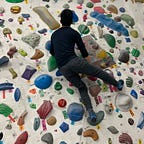25 Takeaways from ‘Highlights from This Neuroscientist Shows You the Secrets to Obtaining A Growth Mindset’
Published in
4 min readDec 10, 2020
Part of the goal of joining Vialchemy is to better understand the mind and mindset. This is my key takeaways from the talk by Tom Bilyeu with Andrew Huberman.
About Tom Bilyeu
Tom Bilyeu is the co-founder of billion-dollar brand Quest Nutrition and the co-founder and host of Impact Theory. Personally driven to expand people’s vision of wellness to a 360-degree view that encompasses body and mind, Tom created Impact Theory to help people develop the skills they will need to improve themselves and the world.
About Dr. Andrew Huberman
a lab director and professor of neuroscience at Stanford University
- Pew Biomedical Scholar Award
- the McKnight neuroscience Scholar Award
- the editorial board of several prestigious journals including Current Biology the Journal of comparative neurology Cell reports
Key Takeaways
- The nervous system’s responsibility is to take sensations that are non-negotiable (light, sounds, etc) and perceive certain ones and not others.
- Your perception is like a window or a spotlight that’s very much linked to attention
- Five brain elements that encompass all of our life experience: sensations, perceptions, feelings, thoughts, and actions.
- Everything about life experience is an abstraction and the brain has a language. It’s creating an abstract representation of everything that’s out there in the world.
- Growth mindset is that it seems like there’s some attachment of the reward systems of the brain to the action or the pursuit of a goal not just achieving a goal
- Dopamine is secreted and rooted to rewards while you pursue rewards.
- the brain only does five things and we get to decide which of those sensations and perceptions have relevance and which ones don’t or which ones are attached to a goal and which ones aren’t.
- Growth mindset in its purest form is the attachment of these reward systems to the effort process to the friction process and not just to obtaining a reward.
- subjective insertion that abstraction that we’re talking about earlier and when you start releasing dopamine to those kinds of things there’s essentially no limit on the number of things you can do or the energy to do them
- attaching your sense of reward to the fact that you’re making action steps that are generally in the right direction. The more you can reward the effort process the better off you are at building these kinds of neural circuits and these kind of tendencies to be able to lean into anything challenging over essentially any duration.
- Little pulses of dopamine allow you to get that action step without the depletion that it would normally bring otherwise
- acetylcholine is the neurochemical that we want to think about anytime we’re talking about neural plasticity and in particular attention high attentional states
- The neuromodulator acetylcholine is secreted when we pay attention to something very specific. it acts as sort of a spotlight in the brain making certain synapses the connections between neurons more active and more likely to be active again than others.
- Eye movement desensitization - lateralized eye movements quiet the amygdala. they actually suppress the activation of this threat detection center in the amygdala.
- forward movement action pushing yourself across that threshold not only rewards you but suppresses the activity of the fear centers in the brain and these are ancient hardwired mechanisms.
- overcoming fear isn’t about diminishing the fear response it’s about making more robust a sense of being brave in the face of that fear.
- Are you gonna try and quiet stress or are you gonna actually lean into action? that’s a critical choice point for everybody who’s experienced anything negative or positive for that matter.
- Your thoughts are ultimately a choice like you get to decide what you think about.
- the ability to tap into this dopamine reward system and the reward system the serotonin oxytocin system is crucial.
- if you are able to get to the point where you get excited about the learning process you get excited about trying something even if you fail that if you can associate in your own mind that I feel better about Who I am because I tried this thing then it begins to stack because even the failures become something that you learn and so you actually have made some progress because you took action because you tried something.
- the actual changes in the brain synapse is the rewiring okay that happens during states of sleep and deep sleep.
- hypnosis seems to capture both the high attentional state and the deep relaxation at the same time it’s this very unusual state of mind where you’re neither asleep nor awake and in tight focus or narrow focus.
- the diaphragm isn’t just designed to move your lungs it also sends a signal through the so-called phrenic nerve back to the brain to inform your brain about the status of your body.
- plasticity states there you want to go the other direction that’s going to be inhaling a lot more than you exhale you’re gonna be driving in more oxygen than you are breathing out generally carbon dioxide and that will lead to states that are kind of more elevated.
- get 2 to 10 minutes of bright light first thing in the morning on waking ideally it’s sunlight you could do it through a window
